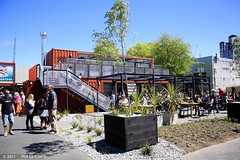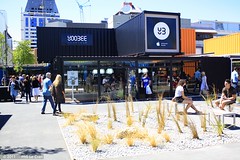
Search
Images for cbd; more images...
Photograph by Jocelyn Kinghorn 1841
Images, UC QuakeStudies
The words "we're ok" spray painted on the fence of a house located in the CBD.
The Unswept Leaves of Chancery Lane
Images, UC QuakeStudies
A view down Chancery Lane through cordon fencing. A sign reading "No Entry" is posted on the fence, and fallen leaves have accumulated around the fence and buildings. The photographer comments, "Chancery Lane in the Christchurch CBD red zone looks like it has had no one through at all since the February earthquake".
Christchurch, NZ - Cashel Mall Restart
Images, eqnz.chch.2010
The CBD is slowly being opened up and this is the post - earthquake result of Cashel Mall. A vibrant, fresh look with high end shopping in colourful container shops. A really good step forward for the city.
Christchurch, NZ - Cashel Mall Restart
Images, eqnz.chch.2010
The CBD is slowly being opened up and this is the post - earthquake result of Cashel Mall. A vibrant, fresh look with high end shopping in colourful container shops. A really good step forward for the city.
Christchurch, NZ - Cashel Mall Restart
Images, eqnz.chch.2010
The CBD is slowly being opened up and this is the post - earthquake result of Cashel Mall. A vibrant, fresh look with high end shopping in colourful container shops. A really good step forward for the city.
Christchurch, NZ - Cashel Mall Restart
Images, eqnz.chch.2010
The CBD is slowly being opened up and this is the post - earthquake result of Cashel Mall. A vibrant, fresh look with high end shopping in colourful container shops. A really good step forward for the city.
Christchurch, NZ - Cashel Mall Restart
Images, eqnz.chch.2010
The CBD is slowly being opened up and this is the post - earthquake result of Cashel Mall. A vibrant, fresh look with high end shopping in colourful container shops. A really good step forward for the city.
Christchurch, NZ - Cashel Mall Restart
Images, eqnz.chch.2010
The CBD is slowly being opened up and this is the post - earthquake result of Cashel Mall. A vibrant, fresh look with high end shopping in colourful container shops. A really good step forward for the city.
Christchurch Press Image: Iain McGregor 2010:09:05 23:17:35
Images, UC QuakeStudies
Photograph captioned by Fairfax, "Major earthquake hits Christchurch. Police and Army personel work to guard the CBD cordons".
CERA says about 100 CBD buildings still to be demolished
Audio, Radio New Zealand
The Canterbury Earthquake Recovery Authority's chief executive, Roger Sutton.
State of Emergency
Images, eqnz.chch.2010
None
Christchurch Press Infographic: 2 November 2012 (3)
Images, UC QuakeStudies
A map showing areas of the central city where brothels will be allowed.
It Sounds Very Painful
Images, UC QuakeStudies
A sign on a cordon fence on St Asaph Street reads "Stop. You must be inducted before entry." The photographer comments, "Safety comes first when it comes to demolition in the earthquake red zone in Christchurch, New Zealand".
Drug Overdose
Images, UC QuakeStudies
A digitally manipulated image of a shop window. A vase is visible in the window, and the sillhouette of a mannequin in the background. The photographer comments, "The title came from the pot and the E on the window. This is a building that has been off limits since the Christchurch earthquake. The E was sprayed on the window by rescue teams after searching the building and finding it was empty. This is a very old wooden building that looks OK from the front, but terrible from the side as the previously adjoined building has been demolished.
Elvis Costello
Images, UC QuakeStudies
A digitally manipulated image of a shop window, with a poster of Elvis Costello visible inside. The photographer comments, "This picture of a young Elvis Costello looks hauntingly out from a badly earthquake damaged shop in Christchurch".
Nisbet, Alistair, 1958- :'CBD Red Zone Tours'. 22 October 2011
Images, Alexander Turnbull Library
Depicts huge elderly woman with 'CERA' on her dress scolding smaller adult dressed as schoolboy near bustop with sign 'CBD red zone tours' Text reads 'And don't talk to strangers and don't cross the road and remember to eat your lunch..' Context: After the 22 Feburary 2011 earthquake in Christchurch, the central business district (CBD) was marked as a red zone. Red zone areas were deemed unsuitable for habitation due to significant damage and at high risk of further damage from low levels of earth shaking. CERA (Christchurch Earthquake Recovery Authority) ran public bus tours of the Christchurch CBD from November to December 2011. For safety reasons the public was not allowed off the buses as it was a dangerous and active demolition site. Quantity: 1 digital cartoon(s).
The impacts of the Canterbury earthquake on the commercial office market
Research Papers, Lincoln University
Lincoln University and CBRE, a commercial real estate service provider, have conducted research to investigate the impacts of the Canterbury earthquake on the commercial office market in Christchurch. The 22 February 2011 Canterbury earthquake had a devastating impact on Christchurch property with significant damage caused to land and buildings. As at January 2012, around 740 buildings have either been demolished or identified to be demolished in central Christchurch. On top of this, around 140 buildings have either been partially demolished or identified to be partially demolished. The broad aims of our research are to (i) examine the nature and extent of the CBD office relocation, (ii) identify the nature of the occupiers, (iii) determine occupier’s perceptions of the future: their location and space needs post the February earthquake, and the likelihood of relocating back to the CBD after the rebuild, and (iv) find out what occupiers see as the future of the CBD, and how they want this to look.
Photograph by Jocelyn Kinghorn 380
Images, UC QuakeStudies
Police and Army personnel work to guard the CBD cordon at the corner of Rolleston Avenue and Armagh Street.
Photograph by Jocelyn Kinghorn 606
Images, UC QuakeStudies
A block of apartments in the CBD that has been yellow-stickered. There is dried liquefaction on the driveway.
Christchurch Press Infographic: 8 December 2012 (1)
Images, UC QuakeStudies
A page banner promoting articles titled, "Antique find: artefacts under building" and, "CBD fire: McKenzie & Willis building ablaze".
Photograph by Jocelyn Kinghorn 381
Images, UC QuakeStudies
Police and Army personnel work to guard the CBD cordon at the corner of Rolleston Avenue and Armagh Street.
IMG_2055
Images, eqnz.chch.2010
Police cordoned off roads to the CBD following the magnitude 7 earthquake in Christchurch on Saturday 4-9-2010.
IMG_2061
Images, eqnz.chch.2010
Police cordoned off roads to the CBD following the magnitude 7 earthquake in Christchurch on Saturday 4-9-2010.
IMG_2057
Images, eqnz.chch.2010
Police cordoned off roads to the CBD following the magnitude 7 earthquake in Christchurch on Saturday 4-9-2010.
IMG_2054
Images, eqnz.chch.2010
Police cordoned off roads to the CBD following the magnitude 7 earthquake in Christchurch on Saturday 4-9-2010.
Residents fear they have lost say in CBD rebuild
Audio, Radio New Zealand
Nearly two years' after Christchurch's February earthquake and almost 6 months after the blueprint for the city centre was revealed, many questions remain about how much it will cost and who will pay for it.
First pictures of fresh quake damage to Chch CBD
Audio, Radio New Zealand
The first media pictures have been taken of the most recent damage to Christchurch's central city in Monday's earthquake.
Progress made on 'dirty 30' derelict Christchurch CBD buildings
Audio, Radio New Zealand
Four years ago Christchurch City Council vowed to get tough on the owners of 30 central city buildings left derelict since the 2011 earthquake. A wander through central Christchurch shows many of the buildings, nicknamed the dirty 30, still look unchanged. There are boarded up windows, tarps covering gaping holes, and containers keeping bricks from falling on passers by. But council says progress is finally being made on most Rachel Graham has more.
Christchurch Press Image: Carys Monteath 2011:04:01 09:06:13
Images, UC QuakeStudies
Photograph captioned by Fairfax, "Earthquake and demolition destruction in Christchurch CBD. Rydges Hotel, Brannigans building and Clarendon Towers, Oxford Terrace".
Peter Walker Photograph 09
Images, UC QuakeStudies
A soldier outside the cordon around the CBD talks on a portable telephone, while a media reporter waits for entry.



